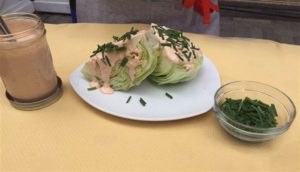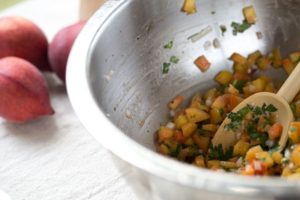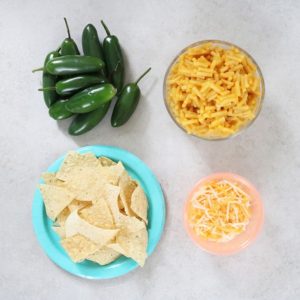Traditionally in Mexico, the quesadilla is a small corn tortilla doubled over a filling of stringy Oaxaca cheese, poblano chili and serrated epazote leaves, and cooked on an ungreased griddle until it’s mottled with brown spots.
But when it crosses the northern border, the quesadilla is gussied up and all kinds of ingredients make their way inside. The tortilla wedge does not differentiate when it comes to cheeses or vegetables/meats and appears as a fried appetizer or grilled entree at a lunch or dinner table. It’s often made with a flour tortilla and loaded with semisoft cheese such as cheddar, and cooked until the cheese melts.
In “Cooking With Cocktails,” author Kristy Gardner says a bottle of St-Germain inspired her to come with the St. Rita quesadillas. The bold and brazen quesadillas are filled with a mushroom-black bean-corn-pickled jalapeno mixture that is spiked with tequila and St-Germain, a fruity-floral liqueur infused with elderflowers. I found citrusy liqueurs such as Grand Marnier or Triple Sec also work just as well.
And that’s not all. A whole cup of cheddar cheese goes into the filling and crumbled feta cheese sits on top. To turn up the heat and flavor, sliced jalapenos and finely chopped cilantro are scattered all over this masterpiece.
You won’t have to worry about serving it with guac, salsa or that lame dollop of sour cream; St. Rita is wondrous just by itself.
— Arthi Subramaniam, Post-Gazette
St. Rita Quesadillas
PG tested
2 tablespoons olive oil, plus more for brushing tortillas, divided
10 ounces baby bella mushrooms, wiped clean and cubed
Coarse sea salt and freshly ground black pepper, to taste
1/2 cup white onion, finely diced
1 (14-ounce) can black beans, drained and rinsed
2 garlic cloves, minced
1 tablespoon pickled jalapeno, diced
1/2 teaspoon ground cumin
2 tablespoons silver tequila
2 tablespoons St-Germain liqueur
1/2 cup frozen corn, thawed
6 medium flour tortillas
6 cups cheddar cheese
1/2 cup crumbled feta
Fresh cilantro, for garnish
1/4 jalapeno pepper, thinly sliced, for garnish
Drizzle 2 tablespoons oil into a large frying pan over medium heat. When oil is hot, add mushrooms and season generously with salt and pepper.
Saute until mushrooms are cooked through and start to get a good amount of color on them.
Add onion and cook for about 5 minutes, or until softened.
Toss in black beans, garlic, pickled jalapeno, cumin, tequila and St-Germain. Cook for 5 minutes, stirring often.
Add the corn and heat through for a couple of minutes.
Pour stuffing mixture into a bowl, wipe out the pan, and place it back on the heat.
Brush one side of a tortilla with a small amount of oil. Place tortilla, oil side down, and cover one-half with 3/4 cup cheddar and 1/2 cup filling mixture.
Add another 1/4 cup cheddar. This will help hold the filling in place.
Using a spatula, fold the empty half of tortilla over the filling. When the bottom gets crispy and cheese starts melting, carefully but swiftly flip over the quesadilla to crisp the other side.
Remove from pan and set aside on a cutting board. Repeat until all quesadillas are made.
Cut quesadillas into quarters and serve sprinkled with feta, cilantro and jalapeno slices.
Serves 6.
— Adapted from “Cooking With Cocktails” by Kristy Gardner (The Countryman Press; February 2017; $29.95)












